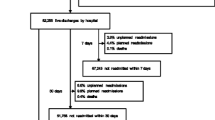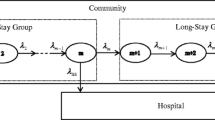Abstract
To improve healthcare quality and reduce costs, the Affordable Care Act places hospitals at financial risk for excessive readmissions associated with acute myocardial infarction (AMI), heart failure (HF), and pneumonia (PN). Although predictive analytics is increasingly looked to as a means for measuring, comparing, and managing this risk, many modeling tools require data inputs that are not readily available and/or additional resources to yield actionable information. This article demonstrates how hospitals and clinicians can use their own structured discharge data to create decision trees that produce highly transparent, clinically relevant decision rules for better managing readmission risk associated with AMI, HF, and PN. For illustrative purposes, basic decision trees are trained and tested using publically available data from the California State Inpatient Databases and an open-source statistical package. As expected, these simple models perform less well than other more sophisticated tools, with areas under the receiver operating characteristic (ROC) curve (or AUC) of 0.612, 0.583, and 0.650, respectively, but achieve a lift of at least 1.5 or greater for higher-risk patients with any of the three conditions. More importantly, they are shown to offer substantial advantages in terms of transparency and interpretability, comprehensiveness, and adaptability. By enabling hospitals and clinicians to identify important factors associated with readmissions, target subgroups of patients at both high and low risk, and design and implement interventions that are appropriate to the risk levels observed, decision trees serve as an ideal application for addressing the challenge of reducing hospital readmissions.







Similar content being viewed by others
References
Medicare.gov. Measures Displayed on Hospital Compare. 2013. http://www.medicare.gov/hospitalcompare/Data/Measures-Displayed.html. Accessed February 25, 2014.
QualityNet. About complication measures, Frequently asked questions: CMS publicly reported risk-standardized outcome measures AMI, HF, and pneumonia mortality and readmission hospital-wide all-cause unplanned readmission THA/TKA readmission and complication. https://staging.qualitynet.org/dcs/ContentServer?c=Page&pagename=QnetPublic%2FPage%2FQnetTier3&cid=1228772780555. Accessed February 26, 2014.
Elixhauser A, Steiner C. Readmissions to US hospitals by diagnosis, 2010. Healthcare Cost and Utilization Project Website. 2013. http://www.hcup-us.ahrq.gov/reports/statbriefs/sb153.pdf. Accessed February 25, 2014.
Medicare Payment Advisory Commission. Report to the Congress: promoting greater efficiency in Medicare. Washington, DC: Medicare Payment Advisory Commission (MEDPAC); 2007.
American College of Emergency Physicians. Medicare’s Hospital Readmission Reduction Program FAQ. Washington, DC. 2013. https://www.acep.org/Legislation-and-Advocacy/Practice-Management-Issues/Physician-Payment-Reform/Medicare-s-Hospital-Readmission-Reduction-Program-FAQ/. Accessed February 25, 2014.
Centers for Medicare and Medicaid Services. Readmissions Reduction Program. Balitmore, MD. 2013. http://www.cms.gov/Medicare/Medicare-Fee-for-Service-Payment/AcuteInpatientPPS/Readmissions-Reduction-Program.html. Accessed February 24, 2014.
Nyce C. Predictive analytics white paper. Malvern: American Institute for CPCU/Insurance Institute of America; 2007.
Eckerson WW. Predictive analytics: extending the value of your data warehousing investment. Data Wareh Inst Best Pract Rep. 2007;1:1–36.
MEDai insights. Data rich, analytics poor: predicting and avoiding preventable 30-day re-hospitalizations. 2011. http://www.writersstudio.com/samples/whitepapers/30-Day%20Readmissions_White%20Paper.pdf. Accessed June 11, 2014.
Kansagara D, Englander H, Salanitro A, Kagen D, Theobald C, Freeman M, et al. Risk prediction models for hospital readmission: a systematic review. JAMA. 2011;306(15):1688–98.
Mohri M, Rostamizadeh A, Talwalkar A. Foundations of machine learning. Cambridge, MA: MIT Press; 2012.
HCUP State Inpatient Databases (SID). Healthcare Cost and Utilization Project (HCUP). Agency for Healthcare Research and Quality, Rockville, MD. December 2013. www.hcup-us.ahrq.gov/sidoverview.jsp. Accessed February 26, 2014.
HCUP Overview. Healthcare Cost and Utilization Project (HCUP). Agency for Healthcare Research and Quality, Rockville, MD. February 2014. http://www.hcup-us.ahrq.gov/overview.jsp. Accessed March 7, 2014.
HCUP Central Distributor. Description of data elements—multiple variables for all states Healthcare Cost and Utilization Project (HCUP). Agency for Healthcare Research and Quality, Rockville, MD. 2008. http://www.hcup-us.ahrq.gov/db/state/siddist/sid_multivar.jsp. Accessed February 26, 2014.
HCUP Central Distributor. Healthcare Cost and Utilization Project (HCUP). Agency for Healthcare Research and Quality, Rockville, MD. 2014. http://www.hcup-us.ahrq.gov/tech_assist/centdist.jsp. Accessed February 26, 2014.
Centers for Medicare and Medicaid Services. ICD-9-CM and ICD-10. Centers for Medicare and Medicaid Services, Baltimore, MD. 2014. http://www.cms.gov/Medicare/Coding/ICD9ProviderDiagnosticCodes/index.html. Accessed February 26, 2014.
Centers for Medicare and Medicaid Services. List of diagnosis related groups (DRGS), FY2008. Baltimore, MD. 2013. http://www.cms.gov/Research-Statistics-Data-and-Systems/Statistics-Trends-and-Reports/MedicareFeeforSvcPartsAB/downloads/DRGdesc08.pdf. Accessed February 26, 2014.
HCUPnet. Calculating readmissions for HCUPnet. Agency for Healthcare Research and Quality, Rockville, MD. November 1, 2012. http://hcupnet.ahrq.gov/HCUPnet.app/Methods-HCUPnet%20readmissions.pdf. Accessed March 7, 2014.
America’s Health Insurance Plans, Center for Policy and Research. Working Paper: simple methods for measuring hospital readmissions rates. Washington, DC: America’s Health Insurance Plans; 2012.
Lee EW. Selecting the best prediction model for readmission. J Prev Med Public Health. 2012;45(4):259–66.
HCUP Clinical Classifications Software (CCS) for ICD-9-CM. Healthcare Cost and Utilization Project (HCUP). Agency for Healthcare Research and Quality, Rockville, MD. January 2014. www.hcup-us.ahrq.gov/toolssoftware/ccs/ccs.jsp. Accessed February 26, 2014.
R Project. The R Project for Statistical Computing. 2014. http://www.r-project.org/. Accessed February 26, 2014.
R Project. Package ‘rpart’: recursive partitioning and regression trees. January 2014. http://cran.r-project.org/web/packages/rpart/rpart.pdf. Accessed February 26, 2014.
Acknowledgments
This work was funded by the UPMC Health Plan. The authors have no conflicts of interest that are directly relevant to the contents of this article.
Author contributions
John P. Hilbert conceptualized and planned the work that led to the development of this manuscript and conducted the modeling and analyses. All authors made substantial contributions to analyzing and interpreting the results and revising the manuscript for important intellectual content. While the first author is the guarantor of the overall content, all authors have approved the final version of the manuscript.
Author information
Authors and Affiliations
Corresponding author
Rights and permissions
About this article
Cite this article
Hilbert, J.P., Zasadil, S., Keyser, D.J. et al. Using Decision Trees to Manage Hospital Readmission Risk for Acute Myocardial Infarction, Heart Failure, and Pneumonia. Appl Health Econ Health Policy 12, 573–585 (2014). https://doi.org/10.1007/s40258-014-0124-7
Published:
Issue Date:
DOI: https://doi.org/10.1007/s40258-014-0124-7




